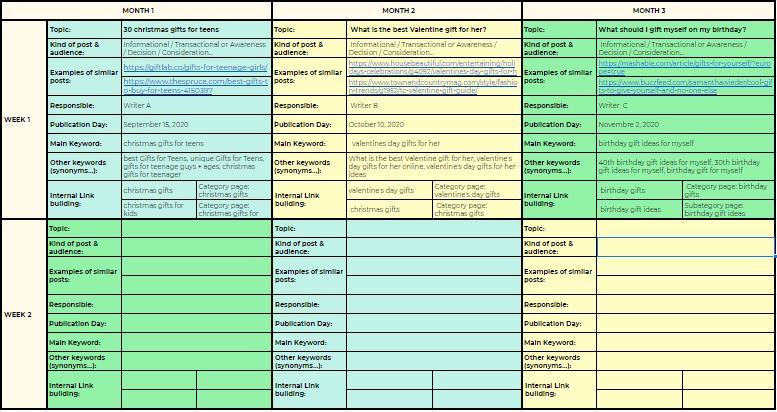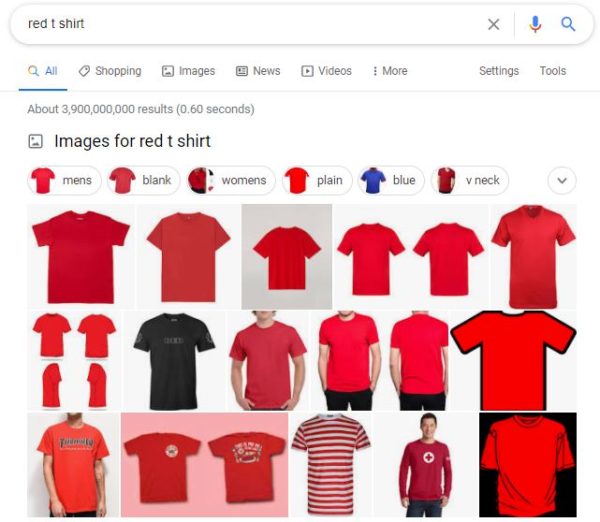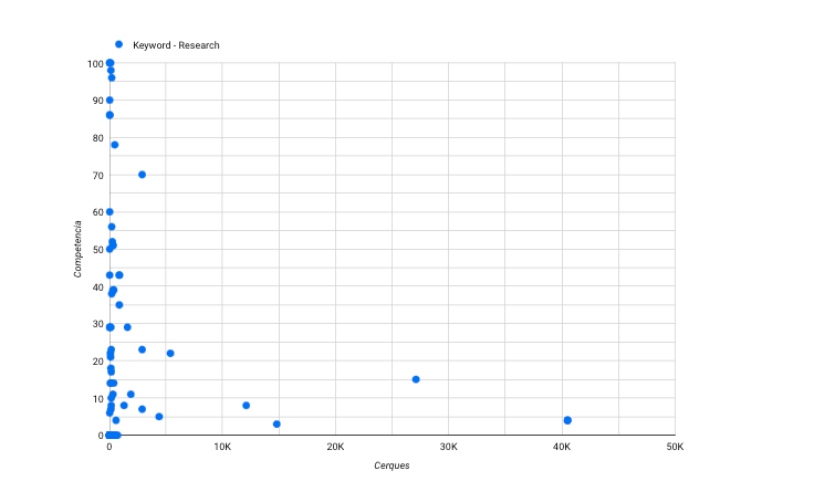Have your blog traffic felt flat after a while and you don’t know how to improve it? Or are your blog posts too repetitive and you don’t have new ideas or topics to write about? Are you looking to achieve this with your blog?

Or do you want to achieve this, by better connecting with your audience interests? Do you want to have a lot of shares, a lot of comments, a lot of likes? Do you want to interact with your audience better?

Source: moz.com
Then this is a solution: creating a content calendar for your blog posts.

Why is it important to have a content calendar in an organization or in an agency?
Let’s start from the beginning. Why is it important that we prepare a content calendar strategy in our business, on our website? There are several reasons.
1.To keep you accountable and in focus to achieve the goals you have set
Well, first of all having a content calendar is having more than just a template, a content calendar would help us to establish our SEO content strategy, to keep us accountable and in focus to achieve our goals that we set for our blog. Even if they are for traffic, engagement, conversion… If we get everything set up, it’s easy for us to always roll in the right direction.
2. To set a better organization between teams
Second of all, a content calendar for our content SEO strategy would help us to set a better organization within all the teams. Why? Well, because for example, if we have a content calendar for our blogs, it will be easier for our social media team to know when we are going to publish some news or some products. Furthermore, it will be also easier to set and align a strategy with the business and sales department.

3.To have a better organization of your content
Third of all, a content calendar template would allow us to have in one place all of our topics and blogs gathered together. So, on one hand, our audience won’t read the same topic twice and second because Google won’t read/crawl our topics twice with the same content (duplicate content) and with the same main keyword (cannibalization).
4.To classify your topics easily
What’s more, a content calendar will also help us to classify our topics easily. So it would be easy for us to focus every blog to our right audience and increase their loyalty. If we gathered all the topics together for our audiences, our different kind of audiences – that we should have already defined! – then we can create content more focused on them and get a higher rate of conversion.

5.To not miss good opportunities because you are late
A content calendar for our blog would also allow you to not miss good opportunities because you are late, such as christmas or black friday campaigns, as in SEO, you have to start some months before, not only some weeks.
6.To work internal Link Building
And last but not least, creating a content calendar four our SEO content strategy would be accountable for us to work internal link building within blogs or other pages (products, categories…).
So, as you see, a well scheduled and aligned blog strategy has the potential to help us achieve success within an SEO process!
And we can verify it with the following example (semrush.com/blog/). In this case, during these last years, this website double its organic traffic due to the blog strategy.

How to create a content calendar for your blog strategy?
So for now, we know why it is important to create a content calendar for our content SEO strategy. But how to create a content calendar for your blog strategy? Let’s go through the process! Let’s learn how to create a content calendar for your blog.
1.Identify your audience
Probably if you work in the marketing industry, you already know it, but it is always important to repeat it! The first thing that we have to do is identify our audience, to know who our audience is because then it will be easier for us to find new topics that they are interested in, related to our products or services. What they need and what they are looking for. If we don’t know our audience, then it will be really difficult for our content strategy actually works.
So, always, the first step is to know our niche and the topics that they are interested in, related to the product or service. What they need and what they are looking for.
2. Do a keyword research
Once we know our audience, once we know who we are trying to achieve, we can start our keyword research but not a “conventional” keyword research. In this case we need to do a keyword research within to find new topics to attract potential clients.
How to do a keyword research with the aim to find new topics to attract potential clients?
a) Define previously the objectives and the competitors with the client.
b) Think about how people will look for your services or product.
The first thing I recommend you to do is to think how people will look for your services or products. You either know you can do it with an Excel sheet, or you can do it with a paper, but you just need to write down how you think that people will look for your service or products. And that’s also you’re serving exactly but also it’s something additional, something related such as how to fix it, clean it, cook it, build it, whatever relates to your product. This would help you to think about different topics or blogs to write about, to arrive to maybe new clients or I don’t know, new audiences that you didn’t know that maybe they could convert on your website.
c) Look in Google suggest and see if that is true…
So once you’ve done that, once you have though how people will look for your services or products, then you just need to go to Google and check if that’s true. Then you can select the results that you think that will fit on your blog, on your website, as these are the services or products that you are selling that you are offering or selling.


…and then verify the selected keywords on Google trends, SEMrush (or other tools) to see how they are changing, total search volume…

d) Select the most interesting keywords
Choose the most interesting terms (keywords), based on the analysis from Google and then keyword research tools, such as Google Keyword Planner, Ahrefs, SEMrush… to analyze the traffic and the competence of the keywords to make your decision.
Which is the best keyword to select for your blog content?
Well, as always in SEO, it depends! It depends a lot according to our goal, the aim of the business, and also the size and capacity of the website. So sometimes, if you are not a big brand or you compete against huge websites, then probably the best option would be to use long-tail keywords (maybe less traffic, but more specific) as they help to focus more on your target.

e) Study your competence
In parallel, when selecting keywords / topics for our content calendar, you should also study the competence and find out the keywords that they use more and bring them more traffic. You can do it with keyword research tools such as SEMrush, where we can learn which keywords are better ranked and which queries get them more traffic (and also, and most important, we can find keyword opportunities here!).
You can check through Google after and study how the pages are and which content are they including for being in the top position for that query.

…and you can do it with keyword research tools.


Classify the keywords that you want to use by topics
So once we have done our research, it is important to classify the keywords correctly so in the future it would be easy for us. A good option is to organize the keywords by topics. You just need to gather all the data together from the research that we did before and left it on the following template (called: Keyword research & Topic categories).
This template would offer you a visual guide that will indicate in which period there are more people looking for each content, each term, each keyword so you would know when is more optimal to work each topic.
On the following example we imagine that we have a gift store, so we want to organize by topics our products depending on the objective of our target:

Find out in which period there are more people looking out for your products
Great. We already have our Keyword research & Topic categories template filled out. Now it is time to interpret it.
By studying the search results, sorted by color, we will know in which periods each keyword has more searches in Google.
For example, Christmas-related products have the highest volume in November and December. So posting a blog at the end of the year will probably not be a good idea if we want to rank a keyword in Google results. It will be important to start working on it many months before.
That’s how this template would help us.

Organize all the data together on the content calendar template
So once we have this, we have everything that we need for our content calendar. Now, with that information, we just need to fill the content calendar template out.
How are we going to fill out the content calendar template?
We need to imagine that probably the blog is going to be written by someone else, usually the content creator of the agency, so we need to leave everything ready for him/her. All the information they would need to write the best post ever!
In this case, my recommendation is that you complete the following fields (we are going to it with the example that we were doing before, with the gift store case):
- Topic: write the topic that the blog is going to talk about. This would be easier for the writer later.
- Kind of post and audience: inform on whom we are writing that blog, which of our audiences.
- Example of similar posts & resources: give them information about other people that wrote about that topic, so they know the model they need to follow.
- Responsible: define who is the person responsible for that content.
- Publication date: indicate which day the blog should be published. This can also help a lot other departments, such as social media.
- Main keyword: principal keyword that we will work on the blog.
- Similar keyword: synonyms or related terms of the main keyword.
- Internal link building: other links of our website that could be linked on that post (category pages, products…).
Others: you can also add other fields depending on your sector, such as sources, images…
…and will have the content calendar template four our SEO content strategy!

However, we need to take into account that we should do this step by step with the client (in case we are an agency…) or with the business department so all the goals are aligned.
I have a content calendar for my blog. What’s next?
So we did it. We created our template and we did it because we want to be better organized and bring more organic traffic to our website. What to do once we achieve it? How we have to write the blogs?

How to increase user’s loyalty and generate conversions with our blogs
We have done an incredible job. We have chosen the best topics and keywords for our SEO content strategy. But, what now? There are some recommendations that we can follow the increase user’s loyalty and generate conversions in our blogs.
Why? Because if we do all that effort and we bring all these people to our websites, and then they don’t have a good experience, they will leave. And we don’t want this to happen. We want them to read it, to enjoy it and to start navigating inside our websites (and generate conversions at the end).
1.Design a correct blog post structure
When writing a blog, one of the most important things to take into account is to write it in a correct structure. Include headings, divide the information with paragraphs… Make it readable, like a newspaper page!
2. Answer your clients needs and questions
Use the blog to answer your clients needs and questions. Think about Google’s Featured Snippets, that will help you to get more traffic.

3.Create good titles and snippets.
Also, it is important to write creative titles and snippets. Focus on your main topic and make it different and original, but also informational -depending on the sector. Usually, having a good title and good snippet related to our topics and keywords will help you also to increase the CTR, the click through rate on the Google search.
4.Use different formats: think with your audience.
And finally what’s also important to do is to use different formats depending on your audience. Sometimes maybe depending on your keyword, your topic or your sector, it’s better if you do videos or if you use a lot of images because this kind of explanation, cause it would help more to answer users needs.


And last but not least… track the results
And last but not least, always in a digital marketing strategy you should track your results to verify if your strategies are working. You can do it with Google Search Console, Google Analytics… You just need to define your metrics and analyze how they are evolving.
Learn more about analytics with the following blog: “Google Analytics 4: Tag Manager, events and conversions”
Still want to know more on how to create a content calendar for you content SEO strategy?
Watch the full presentation called: “How to create a content calendar for your blog”, I did on Content Strategy Lausanne.



